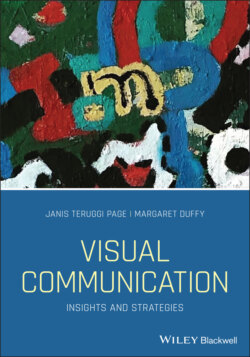Читать книгу Visual Communication - Janis Teruggi Page - Страница 67
REFERENCES
Оглавление1 Anderson, D. (1995). Crime and the Politics of Hysteria. New York: Random House.
2 AP. (n.d.). Visuals. https://www.ap.org/about/news‐values‐and‐principles/telling‐the‐story/visuals (accessed September 3, 2020).
3 Baird, J. (2016). Sara Palin's mustache. New York Times, Feb. 26. http://www.nytimes.com/2016/02/26/opinion/campaign‐stops/sarah‐palins‐mustache.html (accessed February 26, 2020).
4 Ballew, C.C. and Todorov, A. (2007). Predicting political elections from rapid and unreflective face judgments. Proceedings of the National Academy of Sciences of the United States of America 104 (2): 17948–17953.
5 Belluck, P. (2009). Yes, looks do matter. New York Times, April 24. http://www.nytimes.com/2009/04/26/fashion/26looks.html (accessed December 29, 2015).
6 Bird, M. (2002). Robert Capa, in focus. Time, June 30. http://content.time.com/time/magazine/article/0,9171,267730,00.html (accessed February 4, 2016).
7 Bissell, K. (2006). Skinny like you: Visual literacy, digital manipulation, and young women's drive to be thin. Simile: Studies in Media and Information Literacy Education 6 (1): 1–14.
8 Black, J. and Roberts, C. (2011). Doing Ethics in Media: Theories and Practical Applications. New York: Routledge.
9 Bormann, E.G. (1982). A fantasy theme analysis of the television coverage of the hostage release and the Reagan inaugural. Quarterly Journal of Speech 68: 135–145.
10 Brooks, B.S., Horvit, B.J., and Moen, D.R. (2020). News Reporting and Editing. Boston: Bedford/St. Martins.
11 Christians, C.G., Rotzoll, K.B., and Fackler, M. (1987). Media Ethics: Cases and Moral Reasoning, 2e. White Plains, NY: Longman.
12 CNN. (2018). National Park Service edited inauguration photos after Trump, Spicer calls. https://www.cnn.com/2018/09/07/politics/trump‐inauguration‐photos/index.html (accessed December 23, 2020).
13 Entman, R. (1993). Framing: Toward clarification of a fractured paradigm. Journal of Communication 43 (4): 51–58.
14 Gerbner, G. (2003). Television violence: At a time of turmoil and terror. In: Gender, Race, and Class in Media, 2e (eds. G. Dines and J.M. Humex), 339–348. Thousand Oaks, CA: Sage.
15 Gleeson, K. and Frith, H. (2006). (De)constructing body image. Journal of Health Psychology 11 (1): 79–90.
16 Jeong, S. (2008). Visual metaphor in advertising: Is the persuasive effect attributable to visual argumentation or metaphorical rhetoric? Journal of Marketing Communications 14 (1): 59–73.
17 Kravets, D. (2011). Associated Press settles copyright lawsuit against Obama ‘Hope’ artist. https://www.wired.com/2011/01/hope‐image‐flap (accessed September 3, 2020).
18 Kress, G. and van Leeuwen, T. (1998). Front pages: (The critical) analysis of newspaper layout. In: Approaches to Media Discourse (eds. A. Bell and P. Garrett), 186–219. Oxford: Blackwell.
19 Lakoff, G. and Johnson, M. (1980). Metaphors We Live By. Chicago: University of Chicago Press.
20 Lohr, K. (2012). Controversy swirls around harsh anti‐obesity ads. https://www.npr.org/2012/01/09/144799538/controversy‐swirls‐around‐harsh‐anti‐obesity‐ads (accessed September 21, 2020).
21 Maass, P. (2011). The toppling: How the media inflated the fall of Saddam's statue in Firdos square. ProPublica, Jan. 2. http://www.propublica.org/article/the‐toppling‐saddam‐statue‐firdos‐square‐baghdad (accessed February 4, 2016).
22 Miller, J. (2015). How Quentin Tarantino paid homage to Hollywood with his Hateful Eight costumes. Vanity Fair, Dec. 29. from http://www.vanityfair.com/hollywood/2015/12/quentin‐tarantino‐the‐hateful‐eight‐costumes (accessed March 2, 2016).
23 Mitchell, W.J. (1994). The Reconfigured Eye: Visual Truth in the Post‐Photographic Era. Cambridge: MIT Press.
24 Nicas, J. (2016). What happens when virtual reality gets too real? Jan. 4. https://cacm.acm.org/news/196187‐what‐happens‐when‐virtual‐reality‐gets‐too‐real/fulltext
25 Orbach, S. (2011). Losing bodies. Social Research 78 (2): 387–394.
26 Page, J.T. and Duffy, M.E. (2018). What Does Credibility Look like? Tweets and Walls in U.S. Presidential Candidates’ Visual Storytelling. Journal of Political Marketing 17: 1, 3–31, doi: https://doi.org/10.1080/15377857.2016.1171819.
27 Page, J.T., Duffy, M., Frisby, C., and Perreault, G. (2016). Richard Sherman Speaks and Almost Breaks the Internet: Race, Media, and Football. Howard Journal of Communications 27 (3): 270–289. https://doi.org/10.1080/10646175.2016.1176969.
28 Patterson, P. and Wilkins, L. (1997). Media Ethics: Issues and Cases. Boston: McGraw‐Hill.
29 Patterson, P. and Wilkins, L. (2002). Media Ethics: Issues and Cases, 4e. New York: McGraw‐Hill.
30 Phillips, B.J. (2014). Spokes‐characters. In: Brand Mascots: And Other Marketing Animals (eds. S. Brown and S. Ponsonby‐McCabe), 165–174. New York: Routledge.
31 Reaves, S., Bush‐Hitchon, J., Park, S., and Yun, G.W. (2004). If looks could kill: Digital manipulation of fashion models. Journal of Mass Media Ethics 19 (1): 56–71.
32 Ross, S.D. (2011). Introduction. In: Images that Injure: Stereotypes in the Media, 3e (eds. S.D. Ross and P.M. Lester), 1–4. Santa Barbara, CA: Praeger.
33 Ross, W.D. (1930/2002). The Right and the Good, 1e (ed. P. Stratton‐Lake). London: Oxford University Press.
34 Rubin, A. (2015). Flawed justice after a mob killed an Afghan woman. https://www.nytimes.com/2015/12/27/world/asia/flawed‐justice‐after‐a‐mob‐killed‐an‐afghan‐woman.html?_r=0 (accessed September 3, 2020).
35 Stanford . (n.d.). Research into the impact of tobacco advertising. Stanford School of Medicine. http://tobacco.stanford.edu/tobacco_main/images.php?token2=fm_st138.php&token1=fm_img4072.php&theme_file=fm_mt015.php&theme_name=Targeting%20Teens&subtheme_name=Joe%20Camel (accessed February 1, 2016).
36 Strauss, D. L. (2011). Doctored photos: The art of the altered image. https://time.com/3778075/doctored‐photos‐the‐art‐of‐the‐altered‐image (accessed September 3, 2020).
37 Sullivan, M. (2013). Tattoo removal on the photo desk. New York Times. May 18. http://www.nytimes.com/2013/05/19/public‐editor/photo‐manipulation‐on‐the‐fashion‐pages.html (accessed February 4, 2016).
38 Thorson, E. and Duffy, M. (2016). Marbles in the Soup and Crushed Volvos: Ethical Choices on the Advertising Ethics Battlefield. In: In Persuasion Ethics Today, eds Margaret Duffy and Esther Thorson. New York, NY: Routledge.
39 Welch, K. (2007). Black criminal stereotypes and racial profiling. Journal of Contemporary Criminal Justice 23: 276–288.
40 Wilkins, L. (2016). Advertising Ethics: Applying Theory to Core Issues and Defining Practical Excellence. In: Persuasion Ethics Today (eds. M. Duffy and E. Thorson). New York, NY: Routledge.
